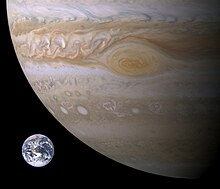| Jupiter radius | |
|---|---|
 The size of Jupiter compared to Earth | |
| General information | |
| Unit system | astronomy |
| Unit of | length |
| Symbol | RJ, RJup,R♃ |
| Conversions | |
| 1 RJ in ... | ... is equal to ... |
| SI base units | 7.1492×107 m[1] |
| English units | 44423 miles |
The Jupiter radius or Jovian radius (RJ or RJup) has a value of 71,492 km (44,423 mi), or 11.2 Earth radii (R🜨)[2] (one Earth radius equals 0.08921 RJ). The Jupiter radius is a unit of length used in astronomy to describe the radii of gas giants and some exoplanets. It is also used in describing brown dwarfs.
The general shape of the planet Jupiter has been directly measured from radio occultations of passing spacecraft, starting with the Pioneer and Voyager missions. This gives an overall margin of error of about 5 km. Estimates of the radii at one bar pressure are then determined through extrapolation. The planet Jupiter has the approximate shape of an oblate spheroid, which is mainly set by the rate of rotation. This gives a difference of about 10% between the polar and equatorial radii. The polar radius has been determined with an accuracy of ±10 km, as of 1987. Density fluctuations within the planet can create variations in the equatorial radius of up to 30 km. The winds in the outer atmosphere can vary the radius by up to 4 km.[3]
In 2015, the International Astronomical Union defined the nominal equatorial Jovian radius to remain constant regardless of subsequent improvements in measurement precision of RJ. This constant is defined as exactly:
- = 7.1492×107 m
Similarly, the nominal polar Jovian radius is defined to be exactly:
- = 6.6854×107 m[1]
These values correspond to the radius of Jupiter at 1 bar of pressure. The common usage is to refer to the equatorial radius, unless the polar radius is specifically needed.
Comparison
| Object | RJ / Robject | Ref |
|---|---|---|
| Lunar radius | 41 | |
| Earth radius | 11.209 | [2] |
| Jupiter | 1 | by definition |
| Solar radius | 0.10045 |
For comparison, one Solar radius is equivalent to:
- 400 Lunar radius (RL)
- 109 Earth radius (R🜨)
- 9.955 Jupiter radius (RJ)
References
- ^ a b Mamajek, E. E; Prsa, A; Torres, G; et al. (2015). "IAU 2015 Resolution B3 on Recommended Nominal Conversion Constants for Selected Solar and Planetary Properties". arXiv:1510.07674 [astro-ph.SR].
- ^ a b Williams, Dr. David R. (2 November 2007). "Jupiter Fact Sheet". NASA. Retrieved 2009-07-16.
- ^ Galanti, E.; Kaspi, Y.; Guillot, T. (March 2023). "The Shape of Jupiter and Saturn Based on Atmospheric Dynamics, Radio Occultations and Gravity Measurements". Geophysical Research Letters. 50 (6). arXiv:2305.02647. Bibcode:2023GeoRL..5002321G. doi:10.1029/2022GL102321. S2CID 257543496. e2022GL102321.











